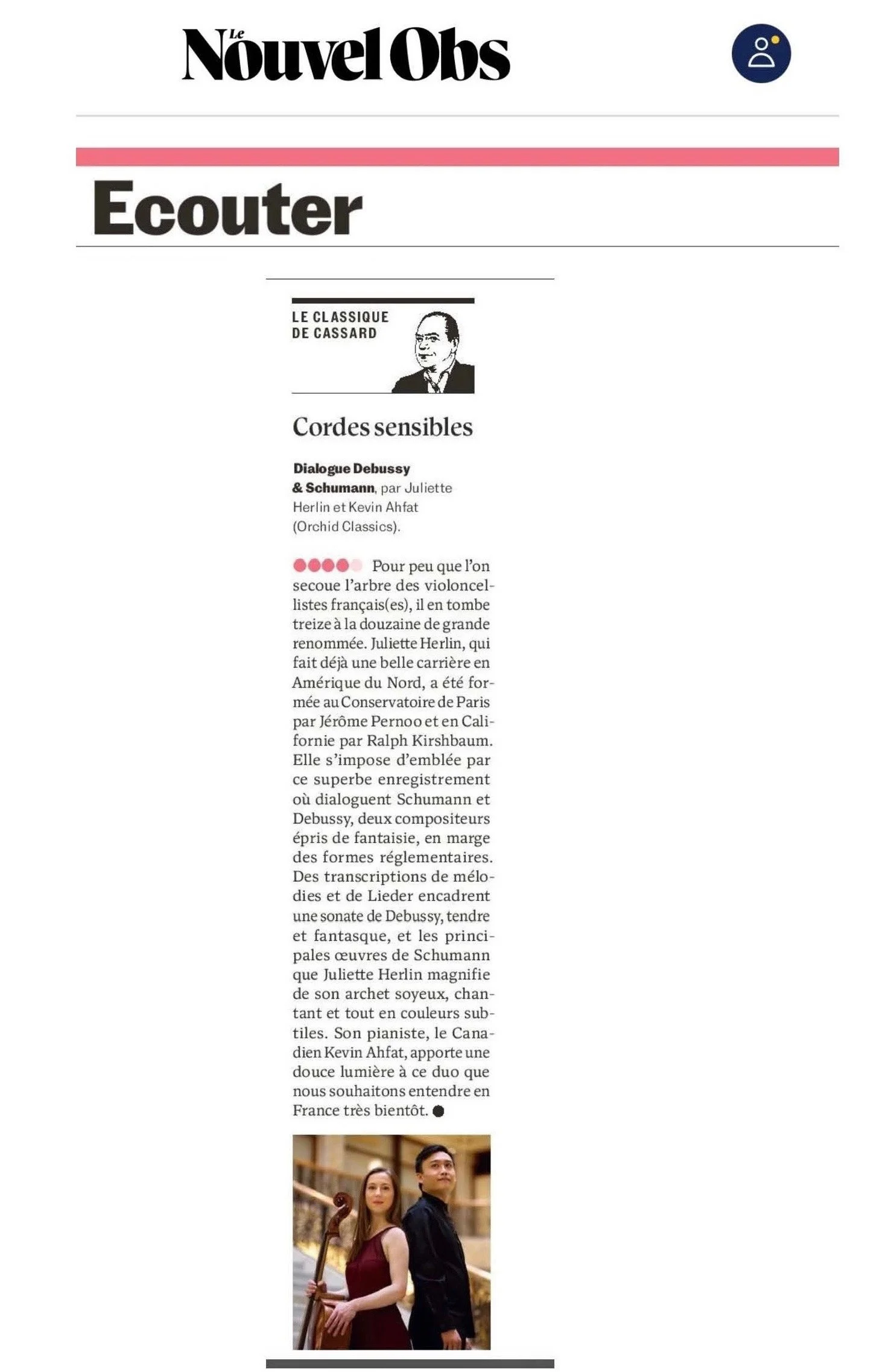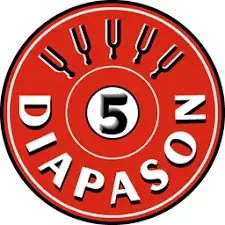DEBUT ALBUM FEATURED IN STRINGS MAGAZINE
THE CONVERSATION
French cellist Juliette Herlin’s ‘Dialogue’ taps into Debussy and Schumann
By Greg Cahill
“The goal was simple enough: Rising star cellist Juliette Herlin set out to record an album that invites listeners to explore the subtle connections between the music of Romantic-era giants. Robert Schumann and Claude Debussy, whose works, the liner notes to Dialogue (Orchid Music) point out, “though separated by time and geography, share a profound musical intimacy. Drawing on both composers’ affinity for the art song and the expressive possibilities of the cello, Dialogue offers a unique perspective on these enduring masterpieces.”
Mission accomplished.
Herlin, 34, accompanied by the sublime pianist Kevin Ahfat, alternates the works to give the listener the sense that these legendary composers are, indeed, engaged in a nuanced musical conversation. […] Along the way, Herlin and Ahfat demonstrate just how richly rewarding a cello and piano pairing can be. […] Strings asked Herlin about the recording of her impressive debut album.”
Read more here.
NOUVEL OBS | ‘DIALOGUE’ REVIEW
⭐️⭐️⭐️⭐️ - New review of ‘Dialogue: Debussy & Schumann’ by Philippe Cassard in the Nouvel Obs.
“She immediately establishes herself with this superb recording where Schumann and Debussy engage in dialogue […] Transcriptions of songs and Lieder frame a sonata by Debussy, tender and whimsical, and the principal works of Schumann, which Juliette Herlin magnifies with her silky bow, singing and full of subtle colors.”
“Elle s’impose d’emblée par ce superbe enregistrement où dialoguent Schumann et Debussy […] Des transcriptions de mélodies et de Lieder encadrent une sonate de Debussy, tendre et fantasque, et les principales œuvres de Schumann que Juliette Herlin magnifie de son archet soyeux, chantant et tout en couleurs subtiles.”
DIAPASON | ALBUM REVIEW: 5 DIAPASONS FOR ‘DIALOGUE’
The September 2025 issue of Magazine includes the a review of cellist Juliette Herlin’s debut album Dialogue.
“The quality of her sound, the firmness of her bow in shaping the music, delicate yet free of any unfortunate sentimentality”, writes Jacques Bonaire, giving the album the highest rating: 5 diapasons.
‘DIALOGUE’ FEATURED ON BBC 3’S IN TUNE
Juliette Herlin’s new album Dialogue: Debussy & Schumann was recently featured on BBC Radio 3’s flagship program In Tune. Host Katie Derham praised the album for its sensitivity and depth, highlighting Herlin’s expressive interpretation of Debussy and Schumann. Dialogue is available to listen now on all major streaming platforms. Listen to the broaddcast here.
JULIETTE HERLIN FEATURED IN THE STRAD MAGAZINE
French cellist Juliette Herlin brings a fresh voice to Debussy’s Rêverie in her latest performance featured on The Strad. Full article here.
GRAMOPHONE FEATURE - VIDEO OF THE DAY
Cellist Juliette Herlin’s Performance of Schumann’s Liederkreis, Op. 39 No. 1 with pianist Kevin Ahfat Featured as Gramophone’s “Video of the Day”
Juliette Herlin has been spotlighted in Gramophone magazine’s “Video of the Day” series for her performance of Robert Schumann’s Liederkreis, Op. 39 No. 1. This recording is part of her forthcoming debut album, Dialogue: Debussy & Schumann, recorded with pianist Kevin Ahfat and set for release on Orchid Classics on June 20th.
The full feature and performance video are available on Gramophone’s website:
Gramophone - Video of the Day
JULIETTE HERLIN NAMED BÄRENREITER JUBILEEE AMBASSADOR
https://100.baerenreiter.com/en/jubilee-ambassadors/
Feature | In a newly uncovered Saint-Saëns sonata, a world of artistic possibilities
https://www.wfmt.com/2019/08/23/in-a-newly-uncovered-saint-saens-sonata-a-world-of-artistic-possibilities/
by Keegan Morris (WFMT Chicago)
It’s not every day an artist can re-discover a piece of music by a master from the Romantic era. Yet this was the enviable privilege of cellist Juliette Herlin, who in 2017 gave one of the first performances since 1919 of a lost cello sonata by Camille Saint-Saëns.
Cellist Juliette Herlin (Photo: Jiyang Chen)
To say that Herlin was raised in a musical household is an understatement: her mother played piano, and her sister played violin. She shares, “I actually wanted to start [playing cello] when I was 3-½-years-old, but I was told I was too small… so I had to wait a year.” She had the additional perk of growing up in a household not only musical but also musicological: her father, Denis, is a musicologist specializing in French music, Debussy in particular.
In 2015 and 2016, Denis Herlin was working with a publisher to release a collection of Saint-Saëns’ complete works. During the project, he uncovered a Saint-Saëns work never before published — a cello sonata. The manuscript, found with other papers from Saint-Saëns’ secretary, was incomplete, containing only the first two movements. “Just a few pages and really not a lot of information about that,” Juliette recounts. “My father actually had to use the type of paper to date the sonata [between 1918 and 1919], and that’s how we know that it’s the third sonata.”
As for the last movements? “It’s still a bit of a mystery,” Juliette explains. There is evidence that the piece was performed complete in 1919, but other manuscripts have yet to surface. It’s possible that what Denis Herlin uncovered was a draft. “What’s a little bit odd is that the manuscript actually stops quite abruptly, in the middle of a page, rather than at the bottom of one page,” the cellist explains. Could it have been writer’s block? This theory seems plausible — in an introduction, Denis Herlin cites letters that show the composer’s frustration with the piece.
A page of the manuscript (courtesy of Juliette Herlin)
“When my father told me about the piece, I was very curious, of course,” Juliette recalls. “I was able to look at the manuscript, and I actually really loved the piece. I loved the simplicity of its texture, and I thought it was just a very interesting work. And the more I was playing it, the more I was working on it, the more I really thought it was fantastic.”
Saint-Saëns wrote for cello more than his contemporaries, but Juliette feels that this third and final sonata cello work bears a resemblance not to others for cello, but to his bassoon sonata, another late-period work.
“It’s interesting, a lot of composers’ works become more and more complex towards the end of their life. And for Saint-Saëns,” she observes, “I feel like he’s going towards simplicity. The sonata is very pure in terms of lines. I think what was really striking to me for this work was the wide range of contrast, colors of sound. There’s a lot of things that one could do with that.” Juliette describes the first movement as joyful and full of energy, and the second movement as more expressive and thematically richer.
Cellist Juliette Herlin and pianist Kevin Ahfat
Adding to the expansive creative possibilities is the fact that the manuscript had few dynamic markings, meaning that Juliette and her collaborator, pianist Kevin Ahfat, had to decide their own. “It was a really interesting process — very freeing and just very rich — because we would experiment and explore new interpretations all the time.”
This scenario seems like an artist’s dream — a clean slate with a highly expressive piece. Indeed, Juliette says, “Most of the time, you have a recording to refer to. This is almost a brand-new piece. You don’t have any other interpretations in your ear, any tradition.” No doubt this mystique piqued audiences’ interest, too. “People really seem to like the piece. Which was nice, because we didn’t exactly know what people would think about this performance of an older work.”
The experience of interpreting the piece has informed Juliette’s playing of other works — “I think that I try and apply the same process to other pieces. Meaning to always try to be as convincing as possible with musical ideas, to try always to keep that freshness, and to always go further, dig further, recreate, refresh.”
Her relationship with the piece has evolved over time, but it still holds a special place in her repertoire and in her career. She reflects, “It’s fun to play the sonata over different years, so I also see how much I’ve grown with it in a way."
Review | Women Reign at Boston Court Pasadena
San Francisco Classical Voice - March 12, 2019
'“The small Boston Court Pasadena theater was gripped by powerful string playing on Saturday night. The concert, “A Companion Guide to Women Composers and Rome” starred an all-women string trio performing works by women composers as well as Andrew Norman’s The Companion Guide to Rome.
[…] Kaija Saariaho’s Sept Papillons for solo cello allowed cellist Juliette Herlin to showcase a wonderful bowing technique. At times, her bow seemed to outline the shape of a butterfly as it followed the natural curve of the cello’s bridge. At one moment, the sound of her fingers tapping on the fingerboard rang out in the hall, before her bow arrived to produce an eerie whisper. She described this work as among her favorite to perform. Her use of harmonics lent a crystalline shine to the work. I saw Herlin perform this same piece several weeks ago at a concert of the Kaleidoscope Chamber Orchestra. The consistency of her quality is impressive, given the work’s technical challenges. […]”
- Ben Kutner
Full review: https://www.sfcv.org/reviews/boston-court-pasadena/women-reign-at-boston-court-pasadena
Review | San Francisco Classical Voice
San Francisco Classical Voice - January 22, 2019
Kaija Saariaho’s Sept Papillons explored the outer ranges of cello technique. The solo piece prominently featured the use of harmonics — notes in which the string is partially held down, allowing only certain overtones to vibrate in the air, producing a transparent and ethereal sound. Cellist Juliette Herlin carried these out with technical accuracy while still bringing impressive artistry to the piece. She held the audience’s attention — no small feat for a piece that highlighted the grit and dissonance inherent in the extremes of extended cello technique.
To read the full review: https://www.sfcv.org/reviews/kaleidoscope-chamber-orchestra/kaleidoscope-brings-athletic-sound-to-new-music?fbclid=IwAR1uB4nI1-TgkW4hBX0hlDSIF-H-LfdHV5ULoh-82xrRGkuNA0W_kDOEWHQ












